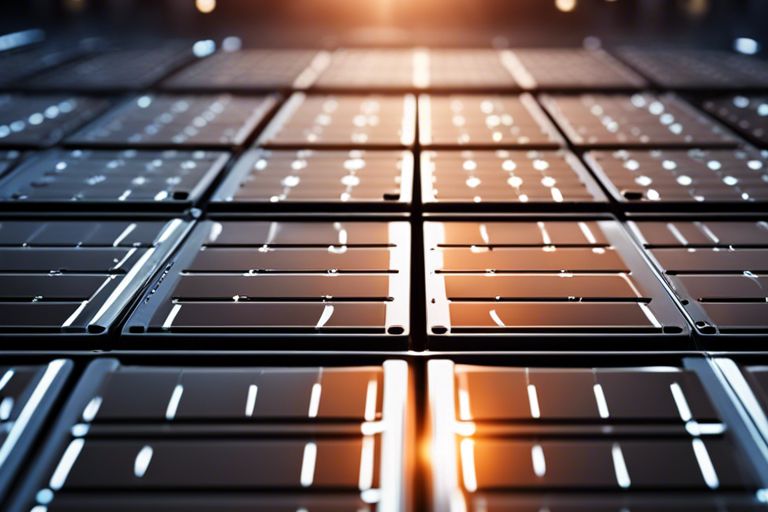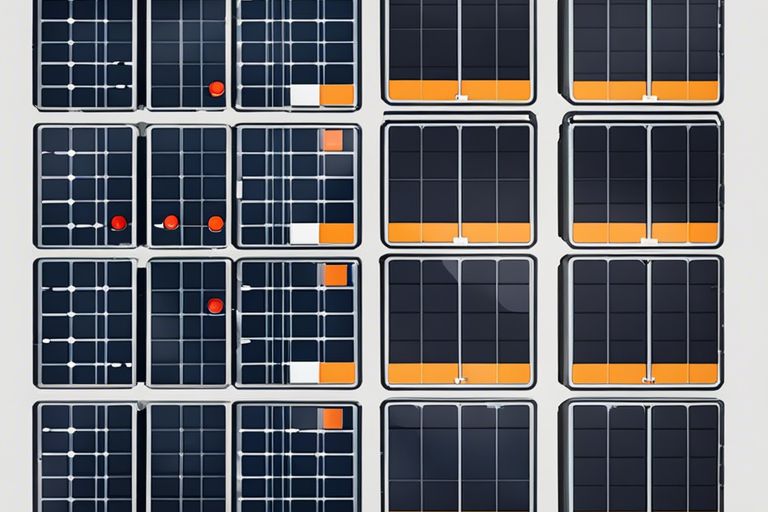With a 300 watt solar panel, you may be wondering how many batteries you need to efficiently store that energy. Let’s investigate into the world of solar power and battery storage to calculate the optimal number of batteries for your setup. Understanding this will help you make the most of your solar energy system’s functionality and ensure a continuous power supply even when the sun goes down.
Key Takeaways:
- Calculate your energy needs: Determine the total wattage of the devices you plan to power with the solar panel to estimate how many batteries you will need.
- Consider battery capacity: Factor in the capacity of the batteries you choose, as this will determine how long your devices can run without sunlight to recharge the batteries.
- Consult a professional: If you are unsure about the optimal number of batteries for your setup, seek advice from a solar energy professional to ensure you have enough power storage for your needs.

Solar Panel Basics
What is a 300-watt solar panel?
The question “Does a 3 (300w) solar panel board enough to fully charge a 2-12v250ah gel battery in one day?” is one that often arises when considering solar panel setups. If you’re wondering about the capabilities of a 300-watt solar panel, it’s crucial to understand its power output. A 300-watt solar panel can produce up to 300 watts of power under ideal conditions, which is enough to charge batteries and power small appliances efficiently.
How does a solar panel generate electricity?
In the context of understanding how a solar panel generates electricity, it’s vital to grasp the basic principles. Solar panels are made up of photovoltaic (PV) cells that convert sunlight into electricity through the photovoltaic effect. This process involves the absorption of sunlight by the PV cells, which then generate an electrical current. The electricity produced by the solar panel can be used to power various devices in your home or stored in batteries for later use. So, by harnessing the power of the sun, you can generate clean and renewable energy for your household needs.
Battery Requirements
Why do I need batteries for my solar panel?
Any solar panel system that aims to provide power when the sun is not shining, such as during the night or on cloudy days, requires batteries to store the excess energy generated during peak sunlight hours. The stored energy can then be used to power your appliances and devices when the solar panels are not actively producing electricity.
What type of batteries are suitable for solar panels?
Any batteries used for solar panels need to be deep cycle batteries, as they are designed to provide a steady amount of power over an extended period of time. Lead-acid batteries, such as sealed lead-acid (SLA) and absorbed glass mat (AGM) batteries, are commonly used in solar panel systems due to their reliability and cost-effectiveness.
When choosing a battery for your solar panel system, consider factors like the battery’s capacity, voltage, cycle life, and temperature sensitivity to ensure optimal performance and longevity of your system.
Calculating Battery Capacity
How to calculate the required battery capacity
All you need to do to determine the required battery capacity for your 300 watt solar panel system is a simple calculation. Start by estimating how many hours of sunlight you get per day on average. If you get around 5 hours of peak sunlight, you can produce 300 watts x 5 hours = 1500 watt-hours (Wh) per day. To ensure you have enough power stored for when the sun isn’t shining, you will need to consider how many days of autonomy you want your system to have. For instance, if you want your system to be able to run for 2 days without sunlight, you would double the daily energy requirement to 3000 Wh.
Factors affecting battery capacity calculations
An important factor to consider when calculating the required battery capacity is the depth of discharge (DoD) you are comfortable with. DoD refers to the percentage of the battery’s capacity that has been used. Most lead-acid batteries have a recommended DoD of 50%, which means you should only use up to half of the battery’s capacity to prolong its lifespan. Additionally, the temperature where the batteries are located can affect their performance. Higher temperatures can reduce the battery’s efficiency, so you may need to adjust your calculations accordingly.
- Ensure your battery’s voltage matches the inverter’s requirements.
- Consider the efficiency losses in charging and discharging the batteries.
- Take into account any future expansions or additions to your solar panel system.
Factors such as the type of battery you choose, the age of the battery, and the maintenance practices you follow can all impact the actual usable capacity of the battery. It is crucial to regularly monitor your battery’s performance and adjust your calculations as needed. After all, the goal is to ensure that your solar panel system can reliably meet your energy needs even in less than ideal conditions.
Battery Size and Configuration
How many batteries do I need for a 300-watt solar panel?
Many factors determine how many batteries you need to complement your 300-watt solar panel setup. To calculate the right number of batteries, you should consider the battery capacity, the amount of energy you use daily, and how many days of autonomy you want in case of cloudy days or low sunlight.
Configuring batteries for optimal performance
For optimal performance, you should configure your batteries in a way that maximizes their efficiency and lifespan. This means choosing the right battery type (such as lead-acid, lithium-ion, or gel batteries), connecting them in series or parallel depending on your system’s voltage requirements, and ensuring proper ventilation to prevent overheating.
For instance, if you opt for lead-acid batteries, you must monitor and maintain them regularly to avoid sulfation, which can reduce their capacity over time. Lithium-ion batteries, on the other hand, are more expensive upfront but last longer and require less maintenance, making them a popular choice for solar panel systems.

Deep Cycle Batteries vs. Regular Batteries
What are deep cycle batteries?
For your solar panel system, you need to consider the type of battery that will best suit your needs. Deep cycle batteries are specifically designed to provide a steady amount of power over an extended period of time. These batteries are built to handle frequent charging and discharging cycles, making them ideal for renewable energy systems like solar panels.
Unlike regular car batteries that are designed for short, high bursts of energy to start a vehicle, deep cycle batteries are constructed with thicker plates and are able to withstand deeper discharges without being damaged. This characteristic makes them more suitable for the sustained, low-power output that solar panels provide.
Why are deep cycle batteries better for solar panels?
solar panels require a battery that can store excess energy generated during the day for use at night or on cloudy days. Deep cycle batteries excel in this scenario as they are built to handle the constant charging and discharging cycles that come with solar panel systems. This ability to be charged and discharged regularly without affecting their lifespan makes deep cycle batteries the superior choice for storing solar energy.
It is important to note that using regular batteries in a solar panel system can lead to premature failure and inefficient energy storage. Regular batteries are not designed to handle the constant cycling required for renewable energy applications like solar panels, making them less reliable and cost-effective in the long run.
Charging and Maintenance
How to charge your batteries with a solar panel
Not all solar panels are created equal when it comes to charging batteries. To charge your batteries efficiently with a 300-watt solar panel, you need to ensure that you have the right charge controller that matches the voltage of your batteries. An MPPT (Maximum Power Point Tracking) charge controller is recommended for optimal charging efficiency.
Tips for maintaining your batteries
Any batteries connected to a solar panel system require regular maintenance to prolong their lifespan and ensure peak performance. Here are some tips to help you maintain your batteries:
- Check the water levels in your lead-acid batteries regularly and top up with distilled water if necessary.
- Inspect the battery terminals for corrosion and clean them with a mixture of baking soda and water if needed.
Any deep cycle batteries used in a solar panel system should be stored in a cool and dry place when not in use to prevent damage and maximize their longevity.

Conclusion
So, in conclusion, for a 300 watt solar panel, you would need at least one 12V battery with a minimum capacity of 25 amp-hours to ensure efficient energy storage. However, for a more reliable power supply, it is recommended to use multiple batteries to increase the total capacity and extend the longevity of your solar power system.
Bear in mind, the number of batteries needed for your solar panel setup may vary depending on factors such as your energy consumption, daily sunlight exposure, and desired backup power. It is always best to consult with a solar energy expert to determine the optimal battery configuration for your specific needs. With the right setup, you can enjoy the benefits of clean, renewable energy while reducing your reliance on traditional power sources.
Q: How many batteries do I need for a 300 watt solar panel?
A: The number of batteries needed for a 300 watt solar panel system depends on the capacity of the batteries and the energy requirements of the appliances you want to power. On average, you would need at least 2-3 deep cycle batteries with a total capacity of around 200-300 amp-hours to store the energy generated by a 300 watt solar panel.
Q: What type of batteries should I use for a 300 watt solar panel system?
A: For a 300 watt solar panel system, it is recommended to use deep cycle batteries as they are designed to provide a steady amount of power over an extended period of time. Lead-acid, lithium-ion, or gel batteries are commonly used for solar panel systems and can work well with a 300 watt setup.
Q: How do I calculate the number of batteries needed for my 300 watt solar panel system?
A: To calculate the number of batteries needed for a 300 watt solar panel system, you first need to determine the daily energy consumption of your appliances in watt-hours. Then, considering factors like battery capacity, depth of discharge, and days of autonomy, you can calculate the total amp-hour capacity required for your system and choose the appropriate number of batteries accordingly.
